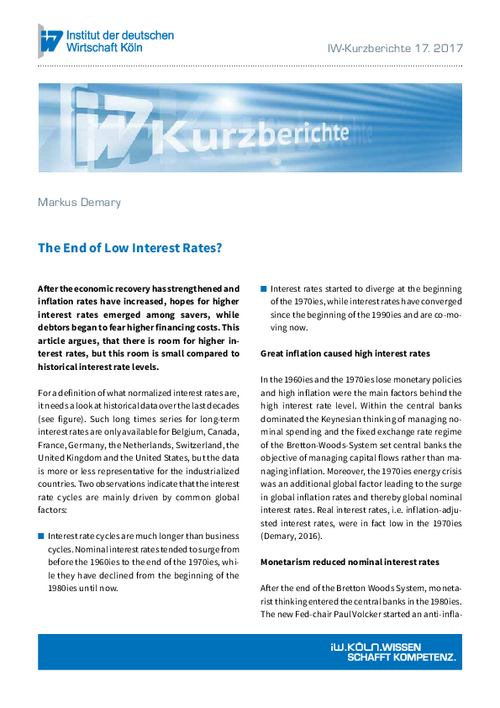After the economic recovery has strengthened and inflation rates have increased, hopes for higher interest rates emerged among savers, while debtors began to fear higher financing costs. This article argues, that there is room for higher interest rates, but this room is small compared to historical interest rate levels.

The End of Low Interest Rates?
IW-Kurzbericht

After the economic recovery has strengthened and inflation rates have increased, hopes for higher interest rates emerged among savers, while debtors began to fear higher financing costs. This article argues, that there is room for higher interest rates, but this room is small compared to historical interest rate levels.
For a definition of what normalized interest rates are, it needs a look at historical data over the last decades (see figure). Such long times series for long-term interest rates are only available for Belgium, Canada, France, Germany, the Netherlands, Switzerland, the United Kingdom and the United States, but the data is more or less representative for the industrialized countries. Two observations indicate that the interest rate cycles are mainly driven by common global factors:
- Interest rate cycles are much longer than business cycles. Nominal interest rates tended to surge from before the 1960ies to the end of the 1970ies, while they have declined from the beginning of the 1980ies until now.
- Interest rates started to diverge at the beginning of the 1970ies, while interest rates have converged since the beginning of the 1990ies and are co-moving now.
Great inflation caused high interest rates
In the 1960ies and the 1970ies lose monetary policies and high inflation were the main factors behind the high interest rate level. Within the central banks dominated the Keynesian thinking of managing nominal spending and the fixed exchange rate regime of the Bretton-Woods-System set central banks the objective of managing capital flows rather than managing inflation. Moreover, the 1970ies energy crisis was an additional global factor leading to the surge in global inflation rates and thereby global nominal interest rates. Real interest rates, i.e. inflation-adjusted interest rates, were in fact low in the 1970ies (Demary, 2016).
Monetarism reduced nominal interest rates
After the end of the Bretton Woods System, monetarist thinking entered the central banks in the 1980ies. The new Fed-chair Paul Volcker started an anti-inflationary monetary policy in the US and other central banks followed with similar monetary policies. The decline in inflation rates in the 1980ies then contributed significantly to the decline in nominal interest rates and the rise in real interest rates (Demary, 2016).
Demographics contributed to lower real rates
The 1990ies were the era of the Great Moderation in which inflation was low and stable around central banks’ inflation targets for which the consensus view of 2 percent over the medium-term dominated. Since that time nominal interest rates have converged mainly due to rising globalization and economic integration. Since inflation was stable, the decline in nominal rates was caused by a trend decline in real rates. This trend was determined by factors that lead to an increase in capital supply, i.e. desired savings, and a fall in capital demand, i.e. desired investment, and this trend is likely to persist in the future.
Demographics contributed to the higher capital supply in two ways. First, the savings of the large cohort of the baby-boomers have increased the aggregate savings rate, so savings can only fall again when this cohort starts leaving the workforce. But the effect of the baby-boomers’ dissaving will probably not be an immediate one and the size of the effect is still uncertain. Second, the life expectancy in the OECD countries increased from 67 years in 1960 to 80 years in 2014, while the retirement age did not increase. When people decide to maintain their old-age consumption levels during a longer retirement period, desired savings during the working life period have to be higher. This effect is expected to be persistent.
Capital demand fell for several reasons. First, investments become less capital-intensive with a trend towards more information and communication technology (Bean et al., 2016). Second, the growth of the labour force slowed down, e.g. from 1.4 percent from 1960 to 1961 to 0.3 percent from 2013 to 2014, which slowed down the necessary growth of the capital stock to maintain the capital-employment ratio. Third, public investment declined, e.g. from 5 percent of the GDP in the 1960ies to 3 percent in 2012 (Demary, 2016). With the need to renew existing infrastructure, for climate-friendly investments and for digital infrastructure, capital demand might increase in the future. But the high sovereign debt levels constrain public investment and the rise of political uncertainty hinders business investment.
Debt-deleveraging forced zero interest rate policies
The declining interest rates during the Great Moderation contributed to the build-up of unsustainable private debt levels which caused the Global Financial Crisis in 2008. Since then many economies experienced a period in which private actors had to cut spending in order to reduce their debt levels. This contributed to slow growth and deflationary pressures on which central banks reacted by ultra-low policy rates and large-scale asset purchase programs (Demary, 2016). But the improving US economy and the now improving Eurozone economies eased the process of debt-deleveraging. In both jurisdictions, demand has normalized now and so have inflation and real growth. The Fed’s and the ECB’s cautious approaches to monetary policy normalization are hard to justify now (Demary/Hüther, 2017).
Fiscal dominance will depress policy rates
When private actors started to deleverage, sovereign debt levels have skyrocketed. Sovereign debt crises can trigger banking crises which can threaten the transmission of monetary policy. A central bank is then forced to keep interest rates low in order to preserve the functioning of its monetary policy. When politicians are aware of this mechanism, the sovereign debt level will become a policy variable. In order to secure low financing conditions, sovereigns will keep debt levels high and thereby force central banks to keep interest rates low (Demary/Hüther, 2017).
The low interest rate period has coincided with a rise in sovereign debt ratios. The US debt ratio rose from 64 percent in the fourth quarter of 2008 to 105 percent in the third quarter of 2016 and in the Eurozone it rose from 69 percent in 2008 to 93 percent in 2016. The sustainability of these debt levels will be a constraint for central banks.
But there is some room for higher rates
Nominal interest rates can either rise because real rates rise or because expected inflation rises. A higher real interest rate cannot be expected for the future due to the trends in demographics and the factors that hinder public and private investment, like the sovereign debt levels and political uncertainty.
A major contributor to the level of nominal interest rates will therefore be inflation. Given the high public debt levels, political pressures on central banks to hold rates down will increase, which will risk that inflation rates overshoot.
An overshooting of inflation will tilt the yield curve. Long-term interest rates, which are less affected by central bank rates, are expected to increase, but short-term rates, e.g. those on savings deposits, which are more affected by the low central bank rates, will turn negative, when adjusted for inflation.
For savers which allocate their wealth in savings deposits, a return of inflation will lead to financial losses. Maintaining the ultra-low interest rate policy further, will cause more damage than good now.

Markus Demary: The End of Low Interest Rates?
IW-Kurzbericht

More on the topic

German Wage Policy between Inflation and Stagnation: Are Conflicts with the Aims of Monetary Policy Looming?
After the economic and financial crisis of 2008/9, the German labour market soon began to recover, creating scope for a comparatively expansive wage policy.
IW
A Macroeconomic Analysis of Wage-Price Spirals
The subject of this Analysis is the forms that wage-price spirals can take and how they influence macroeconomic stability and inflationary trends in Germany.
IW